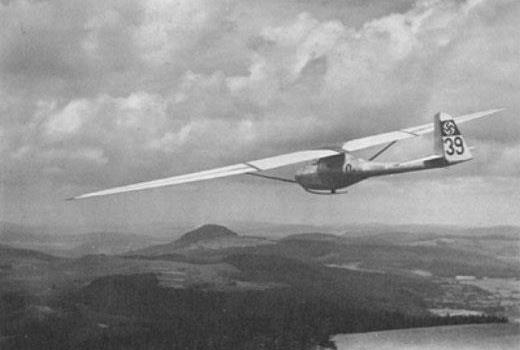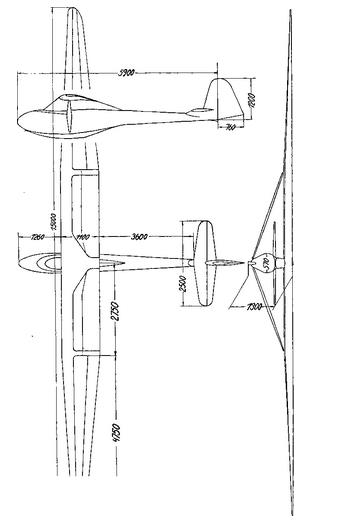| Type | Single seat glider | |
| Dimensions | Length 6,66 m, span 15 m, wing area 12,6 m2, aspect ratio 17,85, root chord 1,22 m, chord at tip 0,44 m, mean chord 0,84 m, width 0.57 m, frontal area 0,56 m2, stabilizer span 1,31 m, area 0,56 m2, fin 0,95 m2 , rudder 0,64 m2 | |
| Weights | Empty 88,6 kg, max. flying weight 173,6 kg, wing load 13,76 kg/m2 | |
| Performance | Max. glide ratio 25 at 72 km/h, min. sink rate 0,54 m/sec. at 65 km/h | |
| Type | Werk.Nr | Registration | History | |
| Built in 1933 | ||||
In 1933 the construction of a glider was (if you do not count the planes Hermann Mayer did) done in the FVA fi. The main reason for the success of the next Mayer aircraft was also the incentive to develop a glider specifically for the cross country flight from thermal to thermal . Hans Sander designed together with Karl Doetsch therefore a light thermal glider, where not only emphasis was placed on the lowest possible rate of descent, but also good speed performance.
The choice of the name "Blaue Maus II" should document that the FVA was willing to build on the excellent gliding achievements from the period and to build a similarly successful glider. The FVA-9 designers Sander and Doetsch has the merit of having awakened after long years purely flying in the FVA to the willingness to develop their own aircraft . F in the team abbreviation returns to its original meaning.
The FVA wrote in "Aviation" 1934, No. 23 on the FVA-9 "Blaue Maus II.":
The FVA-9 is thought by the Akaflieg Aachen as a pure thermal glider. Local conditions make hang gliding limited - the terrain at Orsbach is for all other benefits not high enough to reach cloud terminal - and so arose for us the need to create a glider for thermal flying from start with aerotow. Therefore, special emphasis was placed on good maneuverability at high speed and low speed and light weight in construction.
The wing is designed with a single spar ,planked nose with diagonal plywood. The ribs were tested by thorough strength tests. During building most accurate observance of prescribed dimensions and therefore acheived slightly below the calculated weight.
The fuselage has been developed from the viewpoint of the purpose pure form and then tested on the model in a wind tunnel on its aerodynamic utility.
According to the results of the measurements, the first draft was modified. The body ends in a torque tube. The last two fuselage frames are simultaneously main frames to the skid- The elevator is self-supporting and rests on a structure that grows out of the fuselage. The fittings are bent from sheet steel and welded. The rudder are fixed in ball bearings. This design has proven itself. The operation of the rudder is done with control cables, the ailerons with pipes and control cables.
The design and the experiments were carried out in the past winter months, the construction started at the end of April. It offered no special difficulties as a result of careful design work and drawing sufficient material.The surfaces were produced on a fixture for vertical wing building, for the fuselage was a special fixture made. The ailerons were built for themselves. When planking the use of nail strip was avoided, instead retaining straps used, their possible use is very versatile and especially for the fuselage. The machine was completed in mid-July and tried during the Rhön competition. From their flight characteristics is the good sensitivity of rudder is particularly worthy of mention
The choice of the name "Blaue Maus II" should document that the FVA was willing to build on the excellent gliding achievements from the period and to build a similarly successful glider. The FVA-9 designers Sander and Doetsch has the merit of having awakened after long years purely flying in the FVA to the willingness to develop their own aircraft . F in the team abbreviation returns to its original meaning.
The FVA wrote in "Aviation" 1934, No. 23 on the FVA-9 "Blaue Maus II.":
The FVA-9 is thought by the Akaflieg Aachen as a pure thermal glider. Local conditions make hang gliding limited - the terrain at Orsbach is for all other benefits not high enough to reach cloud terminal - and so arose for us the need to create a glider for thermal flying from start with aerotow. Therefore, special emphasis was placed on good maneuverability at high speed and low speed and light weight in construction.
The wing is designed with a single spar ,planked nose with diagonal plywood. The ribs were tested by thorough strength tests. During building most accurate observance of prescribed dimensions and therefore acheived slightly below the calculated weight.
The fuselage has been developed from the viewpoint of the purpose pure form and then tested on the model in a wind tunnel on its aerodynamic utility.
According to the results of the measurements, the first draft was modified. The body ends in a torque tube. The last two fuselage frames are simultaneously main frames to the skid- The elevator is self-supporting and rests on a structure that grows out of the fuselage. The fittings are bent from sheet steel and welded. The rudder are fixed in ball bearings. This design has proven itself. The operation of the rudder is done with control cables, the ailerons with pipes and control cables.
The design and the experiments were carried out in the past winter months, the construction started at the end of April. It offered no special difficulties as a result of careful design work and drawing sufficient material.The surfaces were produced on a fixture for vertical wing building, for the fuselage was a special fixture made. The ailerons were built for themselves. When planking the use of nail strip was avoided, instead retaining straps used, their possible use is very versatile and especially for the fuselage. The machine was completed in mid-July and tried during the Rhön competition. From their flight characteristics is the good sensitivity of rudder is particularly worthy of mention
Thermik-Segelflugzeug F. V. A. 9.Blaue Maus 2".
Die F.V. A. 9 ist von der Akaflieg Aachen als reines Thermik Segelflugzeug gedacht. Die örtlichen Verhältnisse lassen Hangsegelflug nur in beschränktem Maße zu das Gelände bei Orsbach ist bei allen sonstigen Vorzügen leider nicht hoch genug, um von dort aus Wolkenanschluß zu erreichen , und so ergab sich für uns die Notwendigkeit, ein Segelflugzeug zu schaffen für Thermikflug aus vorangegangenem Flugzeugschlepp. Daher wurde bei der Konstruktion besonderer Wert auf gute
Wendigkeit, auf Schnell- und Langsamflug und geringes Gewicht gelegt.
Der Flügel ist einholmig ausgeführt, die Nase mit Diagonal Sperrholz beplankt. Die Rippen wurden durch eingehende Festigkeitsversuche geprüft. Beim Bau wurde dann später auf genauestes Einhalten der vorgeschriebenen Maße geachtet und so das errechnete Gewicht noch leicht unterschritten.
Der Rumpfumriß wurde unter dem Gesichtspunkt der reinen
1. Flügelbau, Verleimen der Nasenrippen.
2. Flügelbau, Helling für senkrechten Flügelbau ermöglicht gleichzeitigen Bau beider Flächen.
3. Flügelbau, Beplanken der Flügelnase unter Verwendung von Stahlspannbändern.
4. Rumpfbau, Helling mit Spanten.
5. Rumpfbau, Rumpfunterseite teilweise beplankt, auf der Helling.
Zweckform entwickelt und sodann am Modell im Windkanal auf seine aerodynamische Brauchbarkeit geprüft.
Den Ergebnissen der Messungen entsprechend, wurde der erste Entwurf abgeändert. Der Rumpf läuft in ein Torsionsrohr aus. Die beiden letzten Rumpfspante sind gleichzeitig Hauptspante der Kielflosse. Das Höhenleitwerk ist freitragend und ruht auf einem Aufbau, der organisch aus dem Rumpf herauswächst. Die Beschläge sind aus Stahlblech gebogen und geschweißt. Die Ruder sind in Pendelkugellagern gelagert. Diese Ausführung hat sich bewährt. Betätigung der Ruder mit Steuerseilen, der
Querruder mit Stoßstangen und Steuerseilen.
Konstruktion und Versuche wurden in den vergangenen Wintermonaten durchgeführt, der Bau Ende April begonnen. Er bot infolge sorgfältigster Konstruktionsarbeit und ausreichenden Zeichnungsmaterials keine besonderen Schwierigkeiten.
Die Flächen wurden auf einer Helling für senkrechten Flügelbau hergestellt, für den Rumpfeine besondere Helling gebaut. Die Querruder wurden nicht an der Fläche, sondern für sich gebaut. Beim Beplanken wurde der Gebrauch yon Nagelstreifen möglichst vermieden, statt dessen Spannbänder benutzt, deren Verwendungsmöglichkeit auch am Rumpf sehr vielseitig ist. Die Maschine wurde Mitte Juli fertig und während des Rhönwettbewerbes ausprobiert. Von ihren Flugeigenschaften ist die gute
Empfindlichkeit aller Ruder besonders zu erwähnen. Spannweite 15 m, Fläche 12.6 m2, Rüstgewicht 88.6 kg. Zuladung 85 kg. Akaflieg Aachen.
Die F.V. A. 9 ist von der Akaflieg Aachen als reines Thermik Segelflugzeug gedacht. Die örtlichen Verhältnisse lassen Hangsegelflug nur in beschränktem Maße zu das Gelände bei Orsbach ist bei allen sonstigen Vorzügen leider nicht hoch genug, um von dort aus Wolkenanschluß zu erreichen , und so ergab sich für uns die Notwendigkeit, ein Segelflugzeug zu schaffen für Thermikflug aus vorangegangenem Flugzeugschlepp. Daher wurde bei der Konstruktion besonderer Wert auf gute
Wendigkeit, auf Schnell- und Langsamflug und geringes Gewicht gelegt.
Der Flügel ist einholmig ausgeführt, die Nase mit Diagonal Sperrholz beplankt. Die Rippen wurden durch eingehende Festigkeitsversuche geprüft. Beim Bau wurde dann später auf genauestes Einhalten der vorgeschriebenen Maße geachtet und so das errechnete Gewicht noch leicht unterschritten.
Der Rumpfumriß wurde unter dem Gesichtspunkt der reinen
1. Flügelbau, Verleimen der Nasenrippen.
2. Flügelbau, Helling für senkrechten Flügelbau ermöglicht gleichzeitigen Bau beider Flächen.
3. Flügelbau, Beplanken der Flügelnase unter Verwendung von Stahlspannbändern.
4. Rumpfbau, Helling mit Spanten.
5. Rumpfbau, Rumpfunterseite teilweise beplankt, auf der Helling.
Zweckform entwickelt und sodann am Modell im Windkanal auf seine aerodynamische Brauchbarkeit geprüft.
Den Ergebnissen der Messungen entsprechend, wurde der erste Entwurf abgeändert. Der Rumpf läuft in ein Torsionsrohr aus. Die beiden letzten Rumpfspante sind gleichzeitig Hauptspante der Kielflosse. Das Höhenleitwerk ist freitragend und ruht auf einem Aufbau, der organisch aus dem Rumpf herauswächst. Die Beschläge sind aus Stahlblech gebogen und geschweißt. Die Ruder sind in Pendelkugellagern gelagert. Diese Ausführung hat sich bewährt. Betätigung der Ruder mit Steuerseilen, der
Querruder mit Stoßstangen und Steuerseilen.
Konstruktion und Versuche wurden in den vergangenen Wintermonaten durchgeführt, der Bau Ende April begonnen. Er bot infolge sorgfältigster Konstruktionsarbeit und ausreichenden Zeichnungsmaterials keine besonderen Schwierigkeiten.
Die Flächen wurden auf einer Helling für senkrechten Flügelbau hergestellt, für den Rumpfeine besondere Helling gebaut. Die Querruder wurden nicht an der Fläche, sondern für sich gebaut. Beim Beplanken wurde der Gebrauch yon Nagelstreifen möglichst vermieden, statt dessen Spannbänder benutzt, deren Verwendungsmöglichkeit auch am Rumpf sehr vielseitig ist. Die Maschine wurde Mitte Juli fertig und während des Rhönwettbewerbes ausprobiert. Von ihren Flugeigenschaften ist die gute
Empfindlichkeit aller Ruder besonders zu erwähnen. Spannweite 15 m, Fläche 12.6 m2, Rüstgewicht 88.6 kg. Zuladung 85 kg. Akaflieg Aachen.









